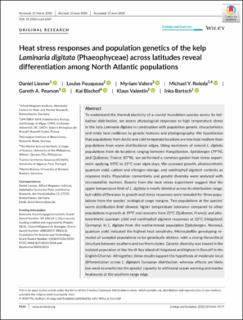Heat stress responses and population genetics of the kelp Laminaria digitata (Phaeophyceae) across latitudes reveal differentiation among North Atlantic populations
| dc.contributor.author | Liesner, Daniel | |
| dc.contributor.author | Fouqueau, Louise | |
| dc.contributor.author | Valero, Myriam | |
| dc.contributor.author | Roleda, Michael Y. | |
| dc.contributor.author | Pearson, Gareth A. | |
| dc.contributor.author | Bischof, Kai | |
| dc.contributor.author | Valentin, Klaus | |
| dc.contributor.author | Bartsch, Inka | |
| dc.date.accessioned | 2020-09-30T10:20:51Z | |
| dc.date.available | 2020-09-30T10:20:51Z | |
| dc.date.created | 2020-09-28T14:54:00Z | |
| dc.date.issued | 2020-08-17 | |
| dc.identifier.issn | 2045-7758 | |
| dc.identifier.uri | https://hdl.handle.net/11250/2680475 | |
| dc.description.abstract | To understand the thermal plasticity of a coastal foundation species across its latitudinal distribution, we assess physiological responses to high temperature stress in the kelp Laminaria digitata in combination with population genetic characteristics and relate heat resilience to genetic features and phylogeography. We hypothesize that populations from Arctic and cold-temperate locations are less heat resilient than populations from warm distributional edges. Using meristems of natural L. digitata populations from six locations ranging between Kongsfjorden, Spitsbergen (79°N), and Quiberon, France (47°N), we performed a common-garden heat stress experiment applying 15°C to 23°C over eight days. We assessed growth, photosynthetic quantum yield, carbon and nitrogen storage, and xanthophyll pigment contents as response traits. Population connectivity and genetic diversity were analyzed with microsatellite markers. Results from the heat stress experiment suggest that the upper temperature limit of L. digitata is nearly identical across its distribution range, but subtle differences in growth and stress responses were revealed for three populations from the species’ ecological range margins. Two populations at the species’ warm distribution limit showed higher temperature tolerance compared to other populations in growth at 19°C and recovery from 21°C (Quiberon, France), and photosynthetic quantum yield and xanthophyll pigment responses at 23°C (Helgoland, Germany). In L. digitata from the northernmost population (Spitsbergen, Norway), quantum yield indicated the highest heat sensitivity. Microsatellite genotyping revealed all sampled populations to be genetically distinct, with a strong hierarchical structure between southern and northern clades. Genetic diversity was lowest in the isolated population of the North Sea island of Helgoland and highest in Roscoff in the English Channel. All together, these results support the hypothesis of moderate local differentiation across L. digitata's European distribution, whereas effects are likely too weak to ameliorate the species’ capacity to withstand ocean warming and marine heatwaves at the southern range edge. | en_US |
| dc.language.iso | eng | en_US |
| dc.publisher | John Wiley & Sons Ltd | en_US |
| dc.rights | Navngivelse 4.0 Internasjonal | * |
| dc.rights.uri | http://creativecommons.org/licenses/by/4.0/deed.no | * |
| dc.subject | Varmebølge | en_US |
| dc.subject | Heat wave | en_US |
| dc.subject | Tang og tare | en_US |
| dc.subject | Seaweeds | en_US |
| dc.subject | Mikrosatellitt | en_US |
| dc.subject | Microsatellite, | en_US |
| dc.title | Heat stress responses and population genetics of the kelp Laminaria digitata (Phaeophyceae) across latitudes reveal differentiation among North Atlantic populations | en_US |
| dc.type | Peer reviewed | en_US |
| dc.type | Journal article | en_US |
| dc.description.version | publishedVersion | en_US |
| dc.rights.holder | This is an open access article under the terms of the Creative Commons Attribution License, which permits use, distribution and reproduction in any medium, provided the original work is properly cited. © 2020 The Authors. Ecology and Evolution published by John Wiley & Sons Ltd | en_US |
| dc.subject.nsi | VDP::Marinbiologi: 497 | en_US |
| dc.subject.nsi | VDP::Marine biology: 497 | en_US |
| dc.subject.nsi | VDP::Marinbiologi: 497 | en_US |
| dc.subject.nsi | VDP::Marine biology: 497 | en_US |
| dc.source.pagenumber | 9144-9177 | en_US |
| dc.source.volume | 10 | en_US |
| dc.source.journal | Ecology and Evolution | en_US |
| dc.source.issue | 17 | en_US |
| dc.identifier.doi | 10.1002/ece3.6569 | |
| dc.identifier.cristin | 1834354 | |
| cristin.ispublished | true | |
| cristin.fulltext | original | |
| cristin.qualitycode | 1 |
Tilhørende fil(er)
Denne innførselen finnes i følgende samling(er)
-
Publikasjoner fra CRIStin - NIBIO [4576]
-
Vitenskapelige artikler [1416]

